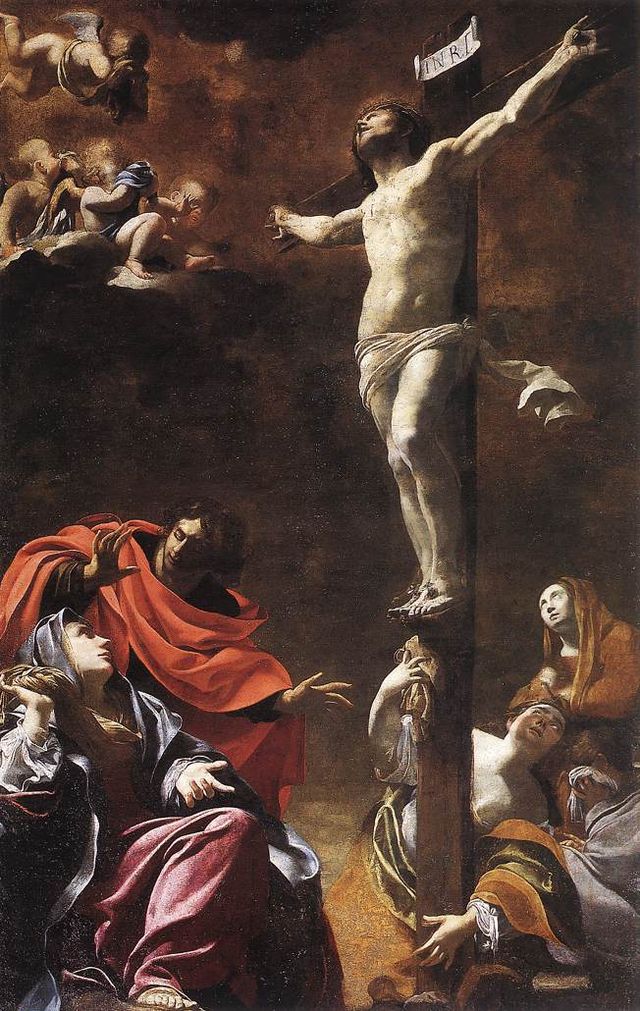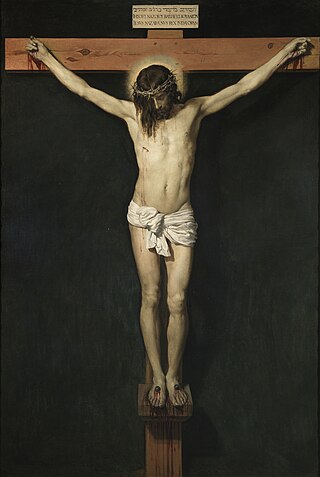耶穌被釘十字架
来自维基百科,自由的百科全书
耶穌被釘十字架(英語:Crucifixion of Jesus),耶穌被逮捕後以十字架處死的事件,一般認為發生在公元1世紀的猶太行省,最可能在公元30到33年之間。雖然歷史學家對這個事件的準確細節並沒有達成共識[1][2],但這個事件在《聖經》中正統的《四福音》皆有描述,在《新約書信》中有提及,而且也被其他古代資料證實,除了基督徒的資料以外,並也被異教徒的史料證實,學者多數認為這是一個歷史事件[3]。

據正統的《四福音》記載,基督耶穌被拘捕、審判,被猶太行省的羅馬總督彼拉多判刑,受到鞭打,最終被羅馬士兵釘十字架。[4]耶穌被剝去衣服,士兵在釘十字架之前讓他喝苦膽調和的酒。然後他被釘死在兩個被判罪的強盜之間;據《馬可福音》記載,耶穌在約六個小時後死了。在這段時間裡,士兵用三種語言在十字架的頂部寫上一個標誌:「拿撒勒的耶穌,猶太人的王。」他們「拈鬮分他的衣服,看是誰得甚麼」。耶穌死後,一位名叫朗基努斯的羅馬士兵以用聖矛刺穿他的肋旁,確定他死了。聖經描述了耶穌在十字架上所說的七句話,以及當時發生的一些超自然現象。
歷史性
耶穌受洗和被釘十字架被認為是歷史中的耶穌的兩個確定歷史事件。[5]詹姆斯·鄧恩(James Dunn)說,「耶穌生平中的這兩個事實幾乎得到普遍認同」,「它是如此真實以至於無法否定或懷疑它的歷史性」,因此它們常常是研究歷史中的耶穌的出發點。[6]巴特·葉爾曼說,耶穌被彼拉多釘十字架是關於他生平的最確定元素。[7]約翰·克洛森說,耶穌被釘十字架是確定的歷史事實。[8]Eddy和Boyd說,現在我們「可以非常肯定」在歷史中非基督徒確認了耶穌被釘十字架的事件。[9]克雷格·布隆伯格(Craig Blomberg)說,大多數學者在第三次探索歷史中的耶穌時認為十字架事件是不可否認的。[10]克里斯托弗·塔克特(Christopher M. Tuckett)指出,儘管很難確定耶穌死亡的確切原因,但關於他的一個不爭事實是他被釘死在十字架上。[11]
雖然學者們同意耶穌被釘十字架的歷史性,但對它的原因和背景提出不同的理論。例如,艾德·帕里什·桑德斯和Paula Fredriksen都支持十字架的歷史性,但認為耶穌沒有預言他自己被釘十字架,他被釘十字架的預言是「教會創造」出來的(第126頁)。[12]Geza Vermes同樣也認為被釘十字架是一個歷史事件,但他提供了自己的解釋和歷史背景。[12]
約翰·梅爾(John P. Meier)認為耶穌被釘十字架是歷史事實,並指出,基於尷尬標準,基督徒不會「發明」自己「領袖的痛苦死亡」。[13]Meier說,許多其他標準,例如多重見證的標準(即,多於一個來源的確認)和一致性標準(即,它與其他歷史元素相符)有助於建立耶穌被釘十字架是一個歷史事件。[14]
雖然幾乎所有與十字架相關的古代資料都是文獻資料,但是1968年在耶路撒冷東北部的一次考古中發現了一具一世紀被釘十字架的屍體。這次發現很好地證實了在羅馬時代存在着釘十字架刑罰,它與福音書描述的耶穌被釘十字架的細節大致相符。[15]被釘十字架的人被確認為Yehohanan ben Hagkol,可能死於公元70年左右,大約在猶太人大起義的時期。哈達薩(Hadassah)醫學院的分析估計,他死於20多歲。另一個相關的考古發現(這次發現的物件也可追溯到公元1世紀左右)是耶路撒冷墓地一個不知名者的帶着釘子的腳跟骨,現在由以色列古物管理局保管,並在以色列博物館展出。[16]
新約的敘述
關於耶穌之死的最早詳細描述包含在《四福音》中。在《新約書信》中還有其他更含蓄的提及。在《對觀福音》中,耶穌三次在不同的事件中預言自己的死亡。[17]所有四個福音書都一致地詳盡記載了耶穌的逮捕、審判、釘十字架、埋葬和復活。在每個福音中,耶穌生命的這五個事件比福音書其他任何部分的記載更為詳盡。學者注意到,讀者在福音書中幾乎能看到每小時發生了什麼。[18]
福音書中結合起來的陳述記載了如下事情:耶穌在與十二門徒最後的晚餐後、在客西馬尼園被捕、然後分別被猶太公會(猶太司法機構)、彼拉多(猶太行省的羅馬總督)和希律·安提帕斯(當時猶太四王制中統治加利利和比利亞郡王)審判,之後加利利郡王希律把耶穌送回彼拉多官邸,最後交給當地羅馬駐軍(第十海峽軍團)釘十字架。[19]耶穌被鞭打後,羅馬士兵嘲笑他為「猶太人的王」,給他穿着一件紫袍(紫袍只有羅馬皇帝才能穿),又用荊棘編做的冠冕(代表羅馬皇帝的槲葉環皇冠)給他戴上、毆打他、吐唾沫在他臉上。然後,耶穌必須走到他被釘十字架的地方。
到了各各他,他們將沒藥調和的酒給耶穌,馬太福音和馬可福音寫到他拒絕了。然後他被釘在十字架上,掛在兩個被判罪的盜賊之間。根據從原初希臘語的一些翻譯,這些盜賊可能是強盜或叛軍。[20]根據馬可福音書,他死前在十字架上被折磨了六個小時,從午正開始(大約早上九點)開始一直到申初(下午三點)[21][22],羅馬人用希臘語、拉丁語和希伯來語三種語言在十字架的頂部寫上一個標誌:「拿撒勒的耶穌,猶太人的王。」他們拈鬮分他的衣服,看是誰得什麼。羅馬士兵沒有打斷耶穌的腿,但他們打斷了其他兩個被釘十字架的盜賊(打斷腿會加快死亡),因為耶穌這時已經死了。每個福音各自記載了耶穌最後的話語,總共有七句。[23]在對觀福音書中,各種超自然事件伴隨着十字架而發生,包括黑暗、地震,和(在馬太福音中)聖徒的復活。在耶穌死後,他的屍體被亞利馬太的約瑟夫從十字架上移走,在尼各底母的協助下被埋在一個岩石鑿成的墳墓。
根據《四福音》,耶穌被帶到「髑髏地」[24],與兩個盜賊一同釘十字架,[25]其罪名是聲稱自己是「猶太人的王」,[26]在斷氣前,[27]他的衣服被士兵瓜分。[28]在他死後,亞利馬太的約瑟從彼拉多那裡要來了屍體,[29]然後約瑟將它安葬在一個新的花園墓地。[30]
三個對觀福音還描述了背十字架的古利奈人西門[31]、無數對耶穌[32]以及盜賊/強盜/反叛者的嘲笑[33]、從午正到申初的遍地黑暗[34]、以及殿裡的幔子從上到下裂為兩半。[35]對觀福音還提到幾個見證者,包括一個百夫長[36]和幾個從遠處觀看的婦女[37],其中兩人參加了埋葬。[38]
路加福音是唯一省略了人們「用海絨蘸滿了醋,綁在葦子上送給耶穌喝」的細節,[39]但是,只有馬可福音和約翰福音描述約瑟確實將屍體從十字架上取下來。[40]
有幾處細節只在一個福音記載中找到。例如,只有馬太福音提到地震、復活的聖徒去了城中,以及羅馬士兵被指派去守衛墳墓[41],而馬可福音是唯一說明了釘十字架的實際時間(第三個小時,或上午9時)和百夫長(一隊羅馬軍隊的指揮官)關於耶穌死亡的報告。[42]路加福音對十字架敘事的獨特貢獻包括:耶穌對哀悼婦人的話、一個罪犯反駁另外一個罪犯的說話、捶着胸回去的聚眾,以及婦女在安息日之前準備香料和油膏。[43]約翰福音是唯一提到要求打斷腿、士兵隨後刺穿耶穌的肋旁(這是對舊約預言的實現),以及尼各底母幫助約瑟埋葬屍體。[44]
根據哥林多前書(林前15:4),耶穌在第三天從死里復活(「在第三天」是以被釘十字架那天作為第一天計算),而且,根據正典福音書,耶穌在升天之前在不同場合向門徒顯現。[45]使徒行傳的說法沒有明確區分發生在復活節星期日的事件和升天的事件,它記載了耶穌與使徒們共處了四十天,這似乎與路加福音的記載不同。[46]然而,大多數聖經學者都同意聖路加同時也寫了「使徒行傳」,並將其作為他所寫的福音書的後續部分,這兩部作品必須考慮為一個整體。[47]
在馬可福音中,耶穌與兩個叛軍一起被釘十字架,白天昏暗了三個小時。耶穌呼求上帝,然後大聲喊叫、死去。聖殿的幔子裂開成兩半。[48]馬太福音遵循馬可福音的說法,也加上了地震和聖徒復活的記載。[49]路加福音也跟隨馬可福音,雖然它描述反叛者是普通罪犯,其中一個捍衛耶穌,耶穌於是承諾他將與自己一起在天堂。[50]路加福音描述耶穌對釘十字架的反應是冷漠的。[51]約翰福音包含了幾個與馬可福音相同的元素,儘管它們以不同的方式來處理。[52]
其它記載與出處
总结
视角
早期非基督徒者提到耶穌被釘十字架的可能是馬拉·巴·謝拉皮翁(Mara Bar-Serapion)給他兒子的信,這是在公元73到3世紀之間寫的。[53]這封信沒有任何基督教主題,作者被推定為異教徒。[54]這封信提到人們不公平對待三個智者(蘇格拉底、畢達哥拉斯和猶太的「智慧之王」。[55]有些學者認為裡面提到對「猶太人的王」的處決指的是耶穌被釘十字架,而其他學者認為這封信沒有什麼價值,因為信中提及的內容非常含糊不清。[56]
在《猶太古史》(約寫於公元93年)中,猶太歷史學家約瑟夫斯(在18篇第3章中)提到耶穌被彼拉多釘十字架,他寫道:
大概現在這個時候,耶穌,一個智者……吸引了許多猶太人和外邦人……彼拉多在我們的領導者的建議下判他有罪,並釘十字架……
大多數現代學者同意,雖然這個約瑟夫斯的段落(稱為Testimonium Flavianum,意為「約瑟夫斯的見證」)包含了一些後來的內插,但它最初是由一個真實的核心構成,即,彼拉多處決耶穌。[57]詹姆斯·鄧恩(James Dunn)指出,學者關於Testimonium Flavianum中描述耶穌被釘十字架的真實性存在「廣泛共識」。[58]在二世紀早期,另一處提到耶穌被釘十字架的是由塔西佗的作品,他通常被認為是最偉大的羅馬歷史學家之一。[59]在《編年史》(約公元116年)中,塔西提斯描述了尼祿對基督徒的迫害,並且提到(《編年史》15.44)彼拉多命令處決了耶穌:[60]
尼祿急於找出縱火者,極端地迫害民眾稱為基督徒的讓人厭惡的團體。基督教的名字來源於Christus,在Tiberius統治時期,他在我們檢察官之一彼拉多的手下遭受極端的懲罰。
學者一般認為,塔西佗提到彼拉多處決耶穌是真實的。作為一個獨立的羅馬來源,它具有重要的歷史價值。[61]Eddy和Boyd說,現在人們可以「堅定地肯定」,塔西佗提供了一個關於耶穌被釘十字架的非基督教的證據。[9]另一個可能提到耶穌被釘十字架(「吊死」,參考路加福音23:39;加拉太書3:13)是在巴比倫的塔木德:
在逾越節前夕,他們吊死了Yeshu,傳令員提前四十天宣稱:「[Yeshu]因為從事巫術,引誘和迷惑以色列人,他將要接受石刑,誰能夠清洗他的罪請站出來,免除他的罪。」但沒有人為他免罪,他們在逾越節的前夕將他吊死。
— Sanhedrin 43a, Babylonian Talmud (Soncino Edition)
雖然,人們有時在Yeshu和耶穌是否是同一個人的問題上有爭議,但許多歷史學家都同意,上述的2世紀段落可能是關於耶穌的。彼得·沙菲爾(Peter Schäfer)表示,毫無疑問,在塔木德中處決Yeshu的敘述指的是拿撒勒的耶穌。[62]Robert Van Voorst指出,可以肯定,在Sanhedrin 43a中指的是耶穌,這不僅可以從文獻本身看出來,而且可以從它的背景看出來[63]
回教徒認為,耶穌沒有被釘死在十字架上,死的是替身。那些猶太人認為殺了耶穌,其實是錯誤地殺死了猶大、古利奈人西門、或另外一個代替耶穌的人。他們這個信念是基於對古蘭經4:157-158的各種解釋,古蘭經寫道:「但他們並沒有殺他,也沒有釘十字架,只是他們看起來是這樣……真主已經將他復活」。[64]
一些早期的基督教諾斯底派教徒認為耶穌基督沒有肉身,認為基督不會被釘十字架。[65]為了回應這種說法,安條克的依納爵堅持認為耶穌是真正的一個人類,並且真正地被釘在十字架上而死,他認為那些相信耶穌受難的人才是真正的基督徒。[66]
釘十字架
關於耶穌被釘十字架的確切日期沒有共識,雖然聖經學者普遍同意,在彼拉多總督(在位時間公元26-36年)的統治期間,這發生在星期五或靠近逾越節(尼散月15日)。[67]學者們估計釘十字架的時間在公元30-33年範圍內,[68]大多數現代學者贊成公元30年4月7日。[69]另一個大多人贊成的日期是公元33年4月3日星期五。[70]
由於在耶穌時代使的是觀察日曆,這包括確定新月和成熟大麥收穫的日期,因此每年逾越節的確切日期或月份都是需要推測的。[71]人們使用各種方法來估計被釘十字架的年份,這些方法包括經典的福音書,保羅的生命年表,以及各種天文模型。
現代學術共識是,新約的記載描述了一個發生在星期五的十字架事件,但發生在星期四或星期三也是可能的。一些學者解釋了發生在星期四是可能的,這是基於「雙重安息日」的解釋,也就說,一個額外的逾越節安息日被安排在星期四黃昏到星期五下午,它在通常的每周安息日之前。[72]有些學者認為,耶穌在星期三而不是星期五被釘十字架,因為馬太福音提到他在周日復活前有「三天三夜」的時間。其他人則反駁說,這忽視了猶太人的習語,「一天一夜」可以指24小時內的任何時刻,馬太福音的表達是慣用表達,而不是說耶穌在墓中過了72小時,因此別的地方說「三天」時不用加上「三夜」。[73]
在馬可福音15:25中,釘十字架發生在第三個小時(上午9時),耶穌在第九個小時(下午3時)死亡。[74]然而,在約翰福音19:14中,耶穌在第六個小時仍在彼拉多面前。學者們提出了許多方法來處理這個問題,而另外的學者提出了一些和解方法,例如,認為約翰福音使用羅馬計時的方法,而路加福音沒有使用這種方法。但是其他人拒絕了這樣的論據。[75]幾個出名的學者認為,現代標記時間的精確方法不應該用回到福音書中,因為那個時候沒有標準化的計時器,沒有準確記錄小時、分鐘的方法,並且時間經常以接近三小時的方法來描述。[76]
三本對觀福音書提到古利奈人西門,他是來扛十字架的,[77]約翰福音則記載耶穌自己「背着」十字架。(約翰福音 19:17)
路加福音還描述了耶穌與大群哀悼的追隨者中的婦人對話,耶穌說:「耶路撒冷的女兒啊,不要為我哭,卻要為你們自己和你們的兒女哭。日子將到,人必說:『不生育的和沒有懷過胎的,也沒有哺養過嬰兒的有福了。』那時人要對大山說:『倒在我們身上!』對小山說:『遮蓋我們!』 他們在青綠的樹上,既然這樣作;在枯乾的樹上,又會怎樣呢?」(路加福音 23:28-31)
在路加福音中,耶穌將這些婦女稱為「耶路撒冷的女兒」,從而將她們與同一福音中描述為「從加利利跟隨他的婦女」(這些婦女在他釘十字架時在場)區分開來。[78]
傳統上,耶穌所走的路稱為苦路,拉丁語「Via Dolorosa」(意為「哀傷的道路」或「苦路」),它是耶路撒冷舊城的一條街道。它由十字架十四站的九個站點所標記。這條穿過Ecce Homo("看,這個人")教堂,而最後五個站是在聖墓教堂裡面。
福音書中並沒有提到傳說中的聖維羅妮卡,但諸如Acta Sanctorum這樣的文獻來源將她描述為耶路撒冷的一個虔誠女人,她帶着憐憫伴隨着背負十字架的耶穌走到髑髏地,並將自己的面紗給他擦拭額頭。[79]
耶穌被釘十字架的確切位置仍然是一個猜測,但聖經的記載表明,它在耶路撒冷城牆外面(約翰福音 19:20;希伯來書13:12),路人可以看到(馬太福音27:39;馬可福音15:21,29-30),並且從遠處也可以觀察到。(馬可福音15:40)該撒利亞的優西比烏確定它的位置只是在錫安山以北,[80]這與現代最多人接受的兩個地點一致。
英文的Calvary是從拉丁語的calvaria(骷髏)翻譯過來的,武加大譯本的「骷髏地」中使用了這個詞語。四個福音書都解釋了這個阿拉姆語詞Gûlgaltâ是耶穌被釘十字架的地名。[81]文本並沒有表明它為什麼這樣確定,但人們提出了幾種理論。一個是,作為公共行刑的地方,Calvary可能遍布着遺棄的受害者的頭骨(這違反了猶太人安葬傳統,但不是違反羅馬的傳統)。另一個理論認為,Calvary以附近的公墓得名(這與人們確定的兩個現代遺址是一致的)。第三個理論是,該名稱源自這個地方的實際輪廓,這解釋了為什麼人們使用這個詞語的單數,即,「骷髏」形的地方。雖然人們經常被稱為「骷髏山」,但它更可能是一個小丘陵或岩石小坡。[82]
傳統的耶穌受難地點位於耶路撒冷老城基督徒區的聖墓教堂內,它在4世紀以來已被證明為耶穌釘十字架的地點。第二個遺址(通常被稱為戈登的骷髏地 [83]),位於老城北部,大馬士革門外,一個被稱為花園墓地的地方,它自19世紀以來一直得到人們的肯定。

《馬太福音》描述了許多釘十字架時在場的婦女,其中一些名字在其它福音書中也提到。除了這些婦女之外,三個對觀福音也談到了其他在場的人:「祭司長和文士並長老」;[84]兩個強盜也被釘在十字架上,一個在耶穌右邊,一個在左邊,[85]路加福音描述他們一個悔改的犯人,另一個是不悔改的犯人;[86]在場的還有「士兵」,即羅馬軍隊,[87]「百夫長(羅馬軍隊指揮官)和一同看守耶穌的人」;[88]路人;[89]「旁觀者」,[90]「聚集觀看的眾人」;[91]和「一切與耶穌熟識的人」。[92]
雖然大多基督徒相信耶穌被處決的絞刑架是傳統的由樑木組成的十字架,但耶和華見證會認為這只是一個直立的木樁。最早基督教作品中使用的希臘詞語和拉丁詞語是模糊的。新約使用的科伊內希臘語是stauros(σταυρός)和xylon(ξύλον)。後者意指木材(活的樹、木料或由木建造成的物體);在希臘語的早期形式中,前一個詞意味着一個直立的樁或杆,但在科伊內希臘語中,它也用來指十字架。[95]拉丁語crux同樣也用來指代十字架以外的對象。[96]
然而,早期的基督教作家談到處死耶穌的特定絞刑架的形狀時總描述它有一個橫樑。例如,馬拉·巴·謝拉皮翁家書[97]有可能寫於公元1世紀,並早於135年,[98]這時,也是關於耶穌之死的福音書寫成的時候;這個家書將絞刑架比喻為字母T(希臘字母tau,數值為300),[99]並認為是摩西在出埃及記17:11-12中所採取的位置。[100]游斯丁(100-165)明確地說,基督的十字架是兩根樑木的形狀:「人們用來完全烤羔的方式象徵着基督在十字架上所經受的痛苦。因為被烤羔羊以十字的方式被烤。一個烤叉直接從底部穿到頭部,一個穿過後背,羔羊的腿被捆綁在這根叉上。」[101]愛任紐死於2世紀末期,他說十字架有「五端,兩個在長上,兩個在寬,一個在中間,人被釘子固定在這個最後的點上。」[102]
兩條樑木的十字架假設並不能決定在釘十字架時使用的釘子數量,一些理論認為使用了三個釘子,而另一些則認為使用了四個釘子。[103]然而,在歷史中,人們曾假設更多的釘子,有時高達14個。[104]這些變化體現在對十字架的藝術描繪。[105]文藝復興之前,西方教會通常會描繪四個釘子,腳的部位並排有兩個釘子。文藝復興後,大多繪畫描繪了三個釘子,一隻腳放在另外一隻上。釘子幾乎總是在藝術作品中被描繪出來,雖然羅馬帝國有時只是將受害者綁在十字架上。[105]這個傳統也用到了基督教的標誌中,例如,耶穌會士在HIS的會標下用三根釘子和十字架表示十字架事件。[106]
釘子究竟在手掌中還是者手腕中也是不確定的。一些理論家認為,手的希臘詞cheir(χειρ)包括手腕,並且行刑的羅馬軍隊士兵通常訓練將釘子穿過Destot的部位(在頭狀骨和月骨之間)而不破壞任何骨頭。[107]另一種理論認為,希臘語的手還包括前臂,因此釘子釘在靠近前臂的橈骨和尺骨那個地方。[108]除了使用指甲外,繩索也用於緊固手。[109]
另一個問題是使用足墊(hypopodium)作為站立平台去支撐腳,這是考慮到手可能不能支持身體的重量。17世紀,拉斯穆·巴多林考慮了這個問題的一些分析場景。[104]20世紀,法醫病理學家Frederick Zugibe使用繩索以各種角度和手的位置懸掛人類受試者,進行了一系列的十字架實驗。[108]他的實驗結果是,十字架是一個有角度的懸掛,一個有兩條樑木的十字架,也許有某種形式的腳部支撐——這是考慮到在一種在直樁上的Aufbinden式的懸掛(這是第二次世界大戰期間納粹在達豪集中營使用的酷刑)——這時,死亡會相當迅速。[110]
關於耶穌在十字架上的說話,新約給了的三種不同敘述。在馬可福音和馬太福音中,耶穌只在十字架上說了一句話,而路加福音和約翰福音則各自描述了三句說話。[111]
Eli, Eli, lema sabachthani?(馬太福音27:46;馬可福音15:34;這是阿拉姆語,意為「我的神,我的神!為什麼你離棄我?」)
這是馬可福音和馬太福音在描述耶穌釘十字架時的唯一說話,引用了詩篇第22篇。由於同一詩篇別的經文也被引用在十字架的敘述上,因此,這句話常常認為是一種文學和神學的創作。然而,Geza Vermes指出,這節經文是以阿拉姆語而不是希伯來語來引用的,它在阿拉姆語中通常會被誦讀,因此他認為,這表明在耶穌時代,這句話已成為一句普遍使用的諺語。[111]與其他福音書中的記載(他將這些記載描述為「神學上的正確和放心的保證」)相比,他認為這個短語是「意外的,令人不安,因此更可能是真實的」。[112]他認為這個短語體現着「極為真實的哭泣的樣貌」。[113]雷蒙德·布朗(Raymond Brown)同樣評論認為,「馬可福音和馬太福音的耶穌引用詩篇來表達被遺棄的感覺是非常真實的,人們很難找到什麼反對意見」。[114]
「父啊,赦免他們!因為他們所做的他們不曉得。」(路加福音:23:34;一些早期手稿並沒有這句。)
「我實在告訴你:今日你要同我在樂園裡了!」(路加福音 23:43)
「父啊,我將我的靈魂交在你手裡!」(路加福音23:46)
路加福音沒有馬太福音和馬可福音中的耶穌的呼喊,可能是弱化耶穌的痛苦,用充滿希望和信心的說話代替一個絕望的呼喊,它遵守了福音的信息,用耶穌自信的死證明了他是神公義的先知。[115]
「母親 ,看,你的兒子!」(約翰福音 19:25-27)
「我渴了。」(約翰福音19:28)
「成了。」(約翰福音19:30)
耶穌在十字架上的話,特別是他最後的話,是無數基督教教義和布道的主題,很多作者專門以基督最後說話寫成書本。[116]詹姆斯·鄧恩(James Dunn)用這些說法之間的差異來懷疑其歷史性。[117]
耶穌在十字架上死亡之前,說出了一個勝利的詞語:tetelestai(成了),希臘詞是指某些事情完成了,成功了,或結束了。[118]
對觀福音記載了在十字架期間的各種神跡事件。[119]馬可福音提到耶穌被釘十字架期間在白天出現的黑暗,耶穌死了時,殿裡的幔子從上到下裂為兩半。路加福音跟隨了馬可福音的說法; 馬太福音也跟隨了馬可福音的說法,而且加入了地震和聖徒的復活。約翰福音沒有提到任何這些東西。[120]
在對觀福音的敘事中,當耶穌掛在十字架上時,猶地亞(或整個世界)的天空「從上午第6時到第9時」(古代時間,現代人時間是從中午到下午中部)「變暗了三個小時(古代時間)」。在約翰福音中沒有提到黑暗,其中,十字架事件在中午之後才發生。[121]
一些基督教作家認為異教徒的評論家可能提到這個事件,誤以為是日食——儘管這不可能發生在逾越節,因為逾越節時是滿月。基督徒旅行家和歷史學家塞克斯塔斯·朱利葉斯·阿弗里卡納斯和基督教神學家奧利振提到了希臘歷史學家Phlegon,後者生活在公元2世紀左右,他寫過「羅馬帝國在皇帝提庇留統治時的日食。在他統治期間,耶穌似乎被釘死,然後發生了大地震。」[122]
塞克斯塔斯·朱利葉斯·阿弗里卡納斯進一步提到了歷史學家Thallus的著作:「在他的歷史著作的第三書中,Thallus稱這個毫無理由的黑暗是日食,因為希伯來人根據月亮在第十四天慶祝逾越節,而我們救主的受難在逾越節前一天;但是,只有當月亮在太陽下時才發生日食。」[123]基督徒護教者特土良認為事件記錄在羅馬的檔案中。[124]
牛津大學的Colin Humphreys和W. G. Waddington認為可能發生的是月食而不是日食。[125]他們得出結論,這樣的日食可從耶路撒冷看到,它持續30分鐘左右,並認為福音提到日食是一個文士錯誤地修訂文本的結果。歷史學家Historian David Henige否定了這個解釋,認為它是「站不住腳的」[126],天文學家布萊德利·謝弗(radley Schaefer)指出,月食在白天時是看不見的。[127][128]
現代聖經研究將對觀福音作者的記敘看成是一種文學創作:由馬可福音的作者開始創作的,並在路加福音和馬太福音書中加以修改,旨在強化他們所認為那些具有神學意義事件的重要性,因此我們不應該從字面上去理解這個事件。[129]這種大地黑暗的意象能被古代讀者所理解,因為這是描寫國王和其他重要人物之死的典型元素,例如作家菲洛、卡西烏斯·狄奧、維吉爾、普魯塔克和約瑟夫斯也採取這種手法。[130]Géza Vermes認為這種黑暗的敘述是典型的「主到來之日的猶太末世景象」,並說,那些將其解釋為日食的人是「誤解了其本意」。[131]
對觀福音書提到,殿裡的幔子從上到下裂為兩半。
《馬太福音》增加了地震、岩石裂開和聖徒墳墓的打開——從猶太末世論文獻的主要主題 ——並描述這些復活的聖徒進入聖城,向許多人顯現。[132]
在馬可福音和馬太福音的記載中,百夫長對這個事件發表評論:「這人真是神的兒子!」(馬可福音 15:39),或:「這真是神的兒子了!」(馬太福音 27:54)。在路加福音中,這變成了「這真是個義人!」 (路加福音 23:47)
在耶穌時代,人們證實了在公元26-36年之間發生了6.3級的大範圍地震。[133]學者們總結說:
這場地震的可能之一是馬太福音中的地震,這是被釘十字架之前或之後某個時間發生的地震,並被馬太福音的作者「借用」了。另一個可能是在公元26至36年之間的地震,它的能量讓恩戈地的沉積物變形,但沒有足夠的能量讓現存的、在聖經之外的歷史記錄下來。如果最後一種可能性是真的,這意味着《馬太福音》的地震報告是一個預言。
醫學方面
醫生和聖經學者提出一些解釋耶穌在十字架死亡情形的理論。 2006年,Matthew W Maslen和Piers D Mitchell審閱了超過40篇關於該主題的出版物,其中包括從心臟破裂到肺栓塞的各種理論。[134]
約翰福音(約翰福音19:34)記載,當羅馬兵用矛刺耶穌肋旁時有血液和水從流出來。1847年,醫生威廉·斯特勞德(William Stroud)根據這個記載提出基督的死是心臟破裂造成的,這個理論影響了許多人。[135]
心血管崩潰理論是一個普遍的現代解釋,它同時表明耶穌死於重度休克。根據這個理論,蹂躪、毆打和固定在十字架上讓耶穌脫水、虛弱和病危,這將導致心血管崩潰。[136]
醫生威廉·愛德華茲和他的同事在《美國醫學協會雜誌上》發文章,支持心血管崩潰(由於低血容量休克)和疲憊窒息的理論,他認為約翰福音中描述耶穌流出的水是(約翰福音19:34)是心包液。[137]
在《耶穌被釘十字架》一書中,醫生和法醫病理學家弗雷德里克·祖吉伯(Frederick Zugibe)詳細地研究了耶穌死亡的可能情況。[138]當他是醫學檢查員時,Zugibe在幾年內進行了很多實驗,以測試他的理論。這些實驗包括:具有特定重量的志願者以特定角度懸掛,並且在腳被固定或未固定的情況下測量每隻手的拉力。在這些情況下,拉力和相應的疼痛是顯着的。[139]
法國醫生、巴黎聖約瑟夫醫院的首席外科醫生Pierre Barbet[140]假設耶穌在面對疲憊的窒息時,必須放鬆肌肉,以獲得足夠的空氣去說他最後的話。[141]Barbet的一些理論,例如釘子的位置,被Zugibe反駁。
矯形外科醫生基思·麥克斯韋(Keith Maxwell)不僅分析了十字架的醫學方面,而且還回顧了耶穌如何能夠背着十字架通過苦街。[142]
在《天主教醫學協會》的一篇文章中,Phillip Bishop和生理學家Brian Church提出了一種基於懸掛創傷的新理論。[143]
2003年,歷史學家FP Retief和L Cilliers審視了羅馬人所執行的十字架酷刑的歷史和病理學,並指出死亡的原因通常是多種因素的組合。他們還說,行刑的羅馬士兵被禁止離開現場,直到罪犯死後才能離開。[144]
神學意義
基督徒相信耶穌的死是為了人類能恢復與上帝的關係。[145]基督徒相信,通過對耶穌的替代性的死亡和勝利的復活[146][147],人們與上帝團聚,在生命中得到新的喜悅和力量,在身體死後得到天上的永生。因此,耶穌被釘十字架與復活恢復人類與上帝充滿生命力的同在,並體驗到愛、恩典以及永生的自信。[148]
從經典福音書到保羅的書信,耶穌的被釘十字架和隨後的復活為基督論的分析提供了豐富的背景。[149]基督徒相信耶穌的受難在希伯來聖經中有預言,例如在詩篇第22篇以及以賽亞的受苦的僕人之歌。[150]
約翰神學的「代理基督論」(agency christology)的觀點認為,耶穌被釘十字架是為了作為神的代理人或神的僕人而作出犧牲,一切是為了最終的勝利。[151]這個觀點建立在約翰福音的救贖主題上,在約翰福音1:34中開始,約翰施洗宣告:「看哪,這是神的羔羊!。」[152]在啟示錄21:14中,這個概念得到進一步強化,「被殺了的羔羊仍舊站立着」,它是唯一一個有能力處理寫着被拯救者名字的捲軸(即,生命冊)。[153]
使徒行傳中出現的一個基督論的核心要素是:人們相信耶穌被釘十字架是「上帝預先知道的,是根據一個確定的計劃」發生的。這個觀點認為,如同使徒行傳2:23所認為的一樣,十字架不被視為醜聞,因為耶穌在「無法無天的人」的手中被釘十字架被視為上帝計劃的實現。[154]
保羅的基督論特別關注耶穌的死亡和復活。對保羅來說,耶穌釘十字架與他的復活直接相關,加拉太書6:12中使用「基督的十字架」一詞可看作是對福音信息的簡寫。對於保羅來說,耶穌被釘十字架不是歷史上一個孤立事件,而是一個具有重大末世論後果的宇宙事件,如哥林多後書2:8所言。在保羅看來,耶穌一直到死也在順服上帝的安排(腓立比書2:8),根據神的計劃「在正確的時間」死了(羅馬書)。對於保羅來說,「十字架的能力」與耶穌的復活是不可分離的。[155]
然而,對耶穌死亡的救贖性質的信念早於保羅書信,並可追隨到基督教和耶路撒冷教會的最早日子。[156]尼西亞信經所說的「為我們被釘在十字架上,受難而被埋葬」反映了這個核心信念在第四世紀已經形成。[157]
讓·加爾文支持「上帝的代理」的基督論,並認為,在彼拉多法院的審判中,耶穌本可以成功地為他的無辜辯護,但他服從了十字架,順從父神。[158]這個基督論的主題一直延續到20世紀,體現在東方和西方教會中。在東正教會,謝爾蓋·布爾加科夫認為,耶穌被釘十字架是由父在世界創造之前「永久」地預先安排好了的,為了將人類從亞當墮落造成的恥辱中解放出來。[159]在西方教會中,卡爾·拉納(Karl Rahner)詳細闡述了上帝的羔羊的血在十字架上流(和水從耶穌肋旁流下構成類比)的類比,認為這具有潔淨的性質,類似於洗禮的水。[160]
耶穌的死和復活支撐着各種關於耶穌如何給予人類救恩的神學解釋。在對耶穌的死和他的話語上的不同強調構成了這些理論之間的差異。[161]根據替代贖罪觀點,耶穌的死是至關重要的,耶穌自願犧牲自己,將其作為完全順服上帝的行為,這是一種讓神喜悅的愛的犧牲。[162]相反,贖罪的道德影響理論更側重於耶穌教導的道德內容,並把耶穌的死看作是殉道。[163]自中世紀以來,這兩種觀點在西方基督教中存在着衝突。福音派新教徒通常贊成替代觀點,特別是贊成刑法替代的理論。自由主義則通常拒絕替代贖罪的觀點,並堅持贖罪的道德影響理論。兩種觀點在羅馬天主教中都很受歡迎,它同時將贖罪的滿足教條納入悔改的觀念中。[162]
在羅馬天主教傳統中,這種贖罪的觀點是由羅馬天主教徒履行償還耶穌基督的法則而得到平衡的[164],在教宗庇護十一世中的通諭Miserentissimus Redemptor中,它被定義為對耶穌受難的「某種償還」。[165]若望·保祿二世提到這個償還耶穌基督的法則「是不斷努力地站在無盡的十字架上,在這些十字架上,神的兒子一直被釘十字架」。[166]
在東正教中,另一個常見的觀點是「基督得勝論」(Christus Victor)。 [167]這意味着耶穌是由神差遣來打敗死亡和撒旦的。因為他是完美的,並且自願死亡和復活,所以耶穌打敗了撒旦和死亡,並勝利地復活。因此,人類不再受罪的約束,而是通過對耶穌的信白白地與上帝和好。[168]
伊斯蘭教
大多伊斯蘭教傳統(除了幾個外)都斷然否認耶穌身體上的死亡,不論是釘十字架而死還是別的方式。這種爭論存在於伊斯蘭傳統中。最早的穆罕默德言行錄記載了穆罕默德的同伴說耶穌死了,而大多數隨後的穆罕默德言行錄和注釋(Tafsir)通過解釋和護教的闡釋操作而否定耶穌之死的結論,這成為流行(正統)的觀點。
教授和學者Mahmoud M. Ayoub繞開了闡釋性的結論,總結了古蘭經:
正如我們已經論證到的一樣,古蘭經並不否認基督的死亡,相反它挑戰人類,這些人類愚蠢地欺騙自己,讓自己相信能戰勝神聖的道,即上帝使者耶穌基督。耶穌的死亡在很多上下文中得到確定。 (3:55; 5:117; 19:33。)[169]
而所涉及到的古蘭經經文有多種解釋。這段古蘭經寫道:
「又因為他們說:「我們確已殺死麥爾彥之子麥西哈‧爾撒,真主的使者。」他們沒有殺死他,也沒有把他釘死在十字架上,但他們不明白這件事的真相。為爾撒而爭論的人,對於他的被殺害,確是在迷惑之中。他們對於這件事,毫無認識,不過根據猜想罷了。他們沒能確實地殺死他。不然,真主已把他擢升到自己那裡。真主是萬能的,是至睿的。」
——古蘭經第四章(婦女)157至158節 surah 4(An-Nisaالنساء)ayah 157-158 [170]
與基督教教義相反,一些伊斯蘭傳統教義認為耶穌上了天堂,而沒有釘十字架,但是上帝改變了另外一個人的容貌,讓他看起來完全像耶穌,然後代替耶穌釘十字架。這個想法是誤讀了愛任紐在反駁2世紀亞歷山大諾斯替信徒巴西利德時的說法,因為諾斯替被認為是否認耶穌死亡的異端。[171]於是,伊斯蘭傳統與基督教的證詞一道認為耶穌的身體上升到天堂,在那裡長留,一直到第二次再臨和世界末日。
十字架在藝術、象徵和靈修中
自耶穌被釘十字架以來,由此十字架成為基督教的關鍵象徵,釘十字架的場景一直是基督教藝術的關鍵要素,產生了具體的藝術主題,如「瞧!那個人」(Ecce Homo)、上十字架、下十字架和埋葬基督。
十九世紀末,詹姆斯·迪索的《釘十字架:從十字架上看到的》的呈現了一種新的方法,它從耶穌的視覺來描繪了十字架的場景。[172]
十字架的象徵是今天最被廣泛認可的基督教符號之一,它從最早基督教時代開始使用的。死於165年的游斯丁描述它時暗示了它是一個象徵,雖然十字架的象徵出現在其後。[173][174]諸如卡拉瓦喬、魯本斯和提香等大師都在的作品中描繪了十字架的場景。
很多基督徒的靈修都是基於十字架以及耶穌受難。「苦路」根據耶穌被釘十字架所涉及到的階段而設定了不同的站點,而「聖傷念珠」則用來冥想耶穌在十字架上的創傷。
聖母瑪利亞在十字架下(約翰福音19:26-27)本身就是瑪利亞藝術的主題,也是眾所周知的天主教象徵的主題,如神跡勳章和若望·保祿二世的徽章中有一個瑪利亞十字架。一些馬利亞的靈修作品描述了聖母瑪利亞在各各他,例如,若望·保祿二世指出「瑪利亞在十字架事件中與耶穌合為一體」。[175]著名的基督教藝術作品,如拉斐爾(例如,Mond Crucifixion)和卡拉瓦喬(例如,耶穌下葬)的作品,也描繪十字架場景中的聖母瑪利亞。
天空黑暗的巧合
漢光武帝建武七年(公元31年)三月癸亥晦,日有食之,避正殿,寑兵,不聽事五日。詔曰:「吾德薄致災,謫見日月,戰慄恐懼,夫何言哉!今方念愆,庶消厥咎。其令有司各修職任,奉遵法度,惠茲元元。百僚各上封事,無有所諱。其上書者,不得言聖。」[176]夏四月壬午,詔曰:「比陰陽錯謬,日月薄食。百姓有過,在予一人,大赦天下。公、卿、司隸、州牧舉賢良、方正各一人,遣詣公車,朕將覽試焉。」[177]
這與對觀福音對耶穌被釘十字架之後天空變暗/日蝕有巧合之處,這裡的癸亥日是指建武七年(公元31年)三月的最後一天。當時東漢的首都在洛陽,時差和耶路撒冷為5個小時。假如這一天文現象出現在耶路撒冷是從中午到下午3點(古代時間6時到第9時,現代人時間是從中午到下午中部)[178],那麼在洛陽,就會是在下午的5點到8點見到這一天文現象。[179]
參考文獻
參見
Wikiwand - on
Seamless Wikipedia browsing. On steroids.

